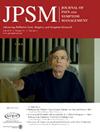Complementary and Alternative Medicine Use in the Last Year of Life: The COMPASS Cancer Cohort Study
IF 3.2
2区 医学
Q2 CLINICAL NEUROLOGY
引用次数: 0
Abstract
Context
There has been growing interest in the role of complementary and alternative medicine (CAM) as part of end-of-life care.
Objectives
This study prospectively examined the prevalence, predictors and outcomes of ingestible CAM use among cancer patients in their last year of life in Singapore.
Methods
This study (N = 427) utilized data across 12 months (four time points) prior to patient death. Utilizing mixed effects logistic regressions, we examined sociodemographic, clinical (symptom burden) and treatment-related factors associated with CAM use. Subsequently, the association between patient quality of life (i.e., physical, social, emotional, functional well-being) and CAM use were examined.
Results
Half of the patients (50%) reported using CAM at least once in the last year of life while 36% of patients reported using CAM in the last 3 months of life. Among CAM users, 67% reported using western herbal supplements while 56% reported using traditional Chinese medicine. Further, 27–28% of patients used CAM consistently (i.e., for six months or more). Most patients (73%) reported using CAM as a complementary treatment. Patients who were ethnically Chinese (OR: 5.59, 95% CI: 2.29–13.69), reported less financial difficulties (OR: 0.82, 95% CI: 0.69–0.98), and believed in other curative treatments for cancer (OR: 2.39, 95% CI: 1.00–5.70) were more likely to use CAM. Controlling for time, CAM use (β: 0.60, CI: 0.01–1.19) was associated with higher social well-being.
Conclusions
A significant proportion of terminal cancer patients reported using CAM as a complementary treatment in the last year of life.
生命最后一年补充和替代药物的使用:COMPASS癌症队列研究。
背景:作为临终关怀的一部分,人们对补充和替代医学(CAM)的作用越来越感兴趣。目的:本研究前瞻性地调查了新加坡癌症患者在生命最后一年使用可摄取CAM的患病率、预测因素和结果。方法:本研究(N=427)利用患者死亡前12个月(4个时间点)的数据。利用混合效应逻辑回归,我们检查了与辅助治疗使用相关的社会人口统计学、临床(症状负担)和治疗相关因素。随后,研究了患者生活质量(即身体、社会、情感、功能健康)与CAM使用之间的关系。结果:一半的患者(50%)报告在生命的最后一年至少使用过一次CAM, 36%的患者在生命的最后3个月报告使用过CAM。在CAM使用者中,67%的人使用西方草药补充剂,56%的人使用传统中药。此外,27-28%的患者持续使用CAM(即6个月或更长时间)。大多数患者(73%)报告使用CAM作为补充治疗。华裔患者(OR: 5.59, 95% CI: 2.29 -13.69),经济困难较少(OR: 0.82, 95% CI: 0.69 - 0.98),并相信其他癌症治疗方法(OR: 2.39, 95% CI: 1.00 - 5.70)更有可能使用CAM。控制时间,CAM的使用(β: 0.60, CI: 0.01 - 1.19)与较高的社会幸福感相关。结论:在生命的最后一年,有相当比例的晚期癌症患者报告使用CAM作为补充治疗。
本文章由计算机程序翻译,如有差异,请以英文原文为准。
求助全文
约1分钟内获得全文
求助全文
来源期刊
CiteScore
8.90
自引率
6.40%
发文量
821
审稿时长
26 days
期刊介绍:
The Journal of Pain and Symptom Management is an internationally respected, peer-reviewed journal and serves an interdisciplinary audience of professionals by providing a forum for the publication of the latest clinical research and best practices related to the relief of illness burden among patients afflicted with serious or life-threatening illness.

 求助内容:
求助内容: 应助结果提醒方式:
应助结果提醒方式:


